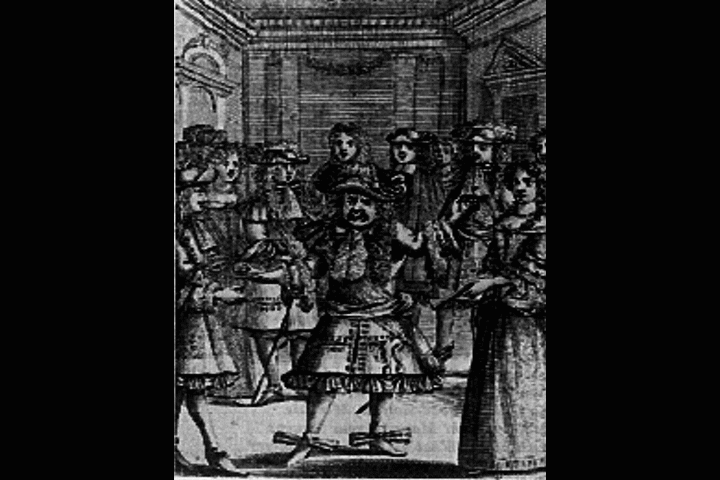 , have had long term associations with companies of actors, and they find
themselves writing for specific actors' strengths in performance.
, have had long term associations with companies of actors, and they find
themselves writing for specific actors' strengths in performance.PLAYWRIGHT part 2
Go back in Playwright reading...
Processes
Playwrights often write many drafts of a play, both before and
after it enters production, before the play reaches its final version
on stage. No matter how carefully the author revises the structure of
a play, the rehearsal process will bring new problems to light and inspire
new ideas. The writer finds what "works" when the play begins to be interpreted
and brought to life by other artists. Many writers, such as Shakespeare
and Moliere (see image) , have had long term associations with companies of actors, and they find
themselves writing for specific actors' strengths in performance.
, have had long term associations with companies of actors, and they find
themselves writing for specific actors' strengths in performance.
There are several terms for structural elements of a plot that will help you to understand the playwright's work more fully, whether you are watching or reading the play. The story of a play is the entire history of the central character or central relationship in the play, including things that happen before and after the play or off stage. The plot is the playwright's selection of elements from the entire story that s/he wants to represent onstage. Different playwrights dramatizing the same story will select different parts of the story and arrive at different plots, depending on their interest in specific character, conflicts, or themes suggested by a story.
The exposition is the early part of a play in which the audience learns where and when the play takes place, who the main characters are, and what the central conflict of the play will be. The audience will also determine the genre of the play and style of production during the exposition. An audience expects and needs this basic information; people are uncomfortable if expository material does not set up basic expectations about the rest of the play. British writer Tom Stoppard parodies this convention in his play The Real Inspector Hound: at the beginning of the play, the maid answers the telephone saying "Hello, the drawing room of Lady Muldoon's country residence one morning in early spring?"
The inciting incident is the first major action that takes place in the plot of a play. It may be a dramatic entrance, or a conflict between two people on stage, or a piece of information uncovered that sets the plot in motion. After the inciting incident, the plot of the play normally builds in suspense until near the end; this is often called rising action. The suspense is created by the playwright's answering the early questions brought forth during the exposition while introducing further, more important problems. The higher the audience's desire to see a resolution to the conflict, the higher the suspense.
The playwright usually introduces many minor conflicts to keep the audience engaged: each scene or section of a scene has a conflict which will develop, reach a climax, then be resolved. Meanwhile, these lesser conflicts will help to build the suspense of the play as a whole. The climax of the play is the point at which the action changes decisively. It may be a truth revealed, a choice made by a major character, or a reconciliation among characters. No matter what kind of event the climax is, the climax marks the "point of no return": the main action or character of the play has moved in a direction from which there is no returning to earlier states of affairs. Because the climax is the decisive turning point of the play, after which suspense diminishes, the climax of most plays is placed near the end of the plot.
Following the climax, the playwright ties up loose ends during the falling action or dénouement. The decisive moment of the climax will determine the resolution of subplots, relationships, and minor characters' dilemmas.
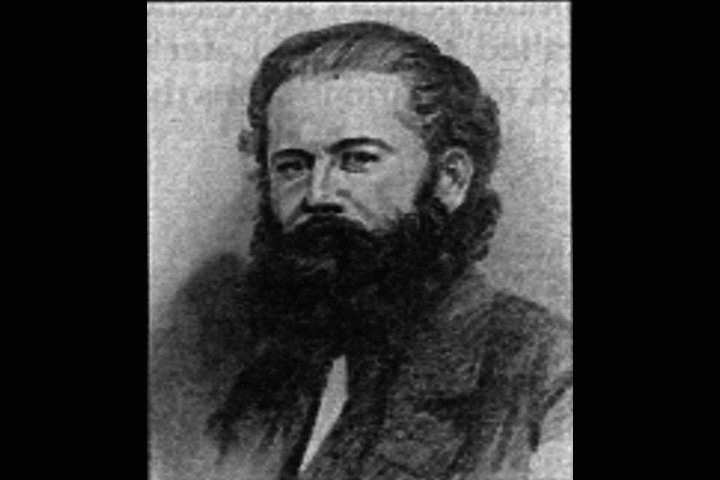 In the nineteenth century, Gustav Freytag graphed out the audience's rising
level of suspense over the length of the play; this has become known as
Freytag's triangle. Also in the nineteenth century, a play that
rigidly adhered to the structural elements outlined above became known
as a "well-made play": a term still used today and often adhered
to by contemporary writers. Henrik Ibsen (see photo), a late 19th century
author said to herald the Modern era of art, was the first master
of the well-made play.
In the nineteenth century, Gustav Freytag graphed out the audience's rising
level of suspense over the length of the play; this has become known as
Freytag's triangle. Also in the nineteenth century, a play that
rigidly adhered to the structural elements outlined above became known
as a "well-made play": a term still used today and often adhered
to by contemporary writers. Henrik Ibsen (see photo), a late 19th century
author said to herald the Modern era of art, was the first master
of the well-made play.
Some playwrights of the twentieth century deliberately avoid conventional
structure. In these cases, the elements that they ignore are a good key
to the playwright's artistic goals in writing that particular play.  For example, Samuel Beckett's (see photo) plays, which are often called
"absurdist", avoid conventional exposition. This sets up a different kind
of audience suspense: the audience tries to figure out who the characters
are, where and when the play is set, and what the action is about throughout
the play. While this can be frustrating for the audience, it is precisely
Beckett's point that our desire for neatly packaged answers to such expository
questions is not reflective of life experience. Instead, we often flounder
for a meaning or explanation without clear guidelines, which is just what
Beckett's audiences experience in watching a play like his Endgame.
For example, Samuel Beckett's (see photo) plays, which are often called
"absurdist", avoid conventional exposition. This sets up a different kind
of audience suspense: the audience tries to figure out who the characters
are, where and when the play is set, and what the action is about throughout
the play. While this can be frustrating for the audience, it is precisely
Beckett's point that our desire for neatly packaged answers to such expository
questions is not reflective of life experience. Instead, we often flounder
for a meaning or explanation without clear guidelines, which is just what
Beckett's audiences experience in watching a play like his Endgame.
Aside from writers like Beckett's deliberate avoidance of conventional structure, playwrights' structures can be divided into two general categories: intensive and extensive. Intensive structure means that a play is highly economical in its use of all elements. "Well-made plays" are intensive in structure. The plot begins late in the story, very near the climax and the plot unfolds in real time or with very little compression of time. The plot unfolds quickly and in a logical manner based on cause and effect or psychological motivation. The inciting incident is like rolling a snowball from the top of a mountain: it gains size and velocity very quickly and moves inexorably toward a the valley floor below where it smashes to earth, in other words towards a climax that will change the characters' lives. All characters and subplots are directly related to the main plot of the play; typically intensive plays will have short cast lists and no subplots. Settings and properties will also be kept to a minimum. When everything extraneous is stripped from the stage, the remaining characters, locations and properties that are placed on stage by the author take on added importance. For example, if you see a gun on stage, it will go off before the play ends, like in Ibsen's Hedda Gabler. Along with Henrik Ibsen's and other nineteenth century "well made plays", Greek tragedies like Sophocles' Oedipus Rex, neoclassical plays like those of Moliere, and many contemporary domestic dramas like Tennessee Williams' The Glass Menagerie or Lorraine Hansberry's A Raisin in the Sun share an intensive structure.
An extensive plot structure will often select dramatic highlights
of a story to string together into a plot; such plays will jump easily
from one time and place to another time and place. Characters may age
significantly or the plot could encompass generations. 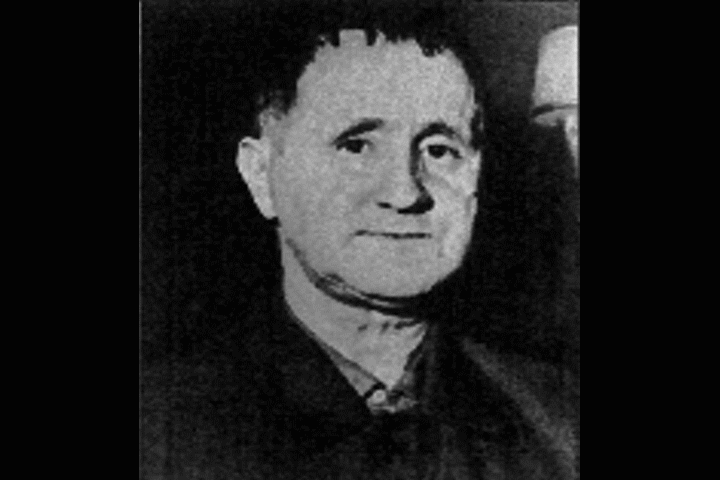 Most extensively structured plays will feature subplots that reflect the
themes and actions of the main plot, and they will have many characters
who contrast with or clarify the main characters. The effect of an extensive
plot structure on the audience is less like a runaway snowball or train;
while an extensive plot should have some momentum, its central themes
and the roles of all of the characters will probably fall together more
like a puzzle: the pattern becomes clearer as the play progresses, but the
full breadth and scope of the playwright's design is not clear until the
end of the play. Shakespeare's plays, Brecht's plays, and more recently,
Tony Kushner's Angels in America are examples of plays with extensive
structure.. At the extreme end of the extensive spectrum are plays with episodic
plots, such as some of those by Bertolt Brecht (see photo). In episodic plays,
each scene functions like a miniature play of its own, complete in and of
itself.
Most extensively structured plays will feature subplots that reflect the
themes and actions of the main plot, and they will have many characters
who contrast with or clarify the main characters. The effect of an extensive
plot structure on the audience is less like a runaway snowball or train;
while an extensive plot should have some momentum, its central themes
and the roles of all of the characters will probably fall together more
like a puzzle: the pattern becomes clearer as the play progresses, but the
full breadth and scope of the playwright's design is not clear until the
end of the play. Shakespeare's plays, Brecht's plays, and more recently,
Tony Kushner's Angels in America are examples of plays with extensive
structure.. At the extreme end of the extensive spectrum are plays with episodic
plots, such as some of those by Bertolt Brecht (see photo). In episodic plays,
each scene functions like a miniature play of its own, complete in and of
itself.
Characters also serve structural functions in drama, like in novels. Many character types and the structural functions they serve within the play have been passed down through centuries of dramatic history, with each generation of playwrights altering the dramatic type to serve contemporary purposes. Characters in serious plays tend to be particularly well defined, or three dimensional. We are expected to identify with these characters and experience them as like ourselves or like people we know.
A different purpose for dramatic characters, equally valid, is to make us laugh. If we are to laugh at characters, we do not want to identify with them too closely. Thus, comedies, especially the broad comedies called farces, tend to have more two dimensional or stock characters. These characters are intentionally drawn in broad strokes; they have just a handful of defining features, which are usually exaggerated to a humorous level. Consider the Three Stooges as an extreme example of farcical characters.
Most plays, dramas or comedies, will have a protagonist and an antagonist. The protagonist refers to the hero of the play and the antagonist creates the conflict, and is usually a "bad guy". These terms come from Ancient Greece, where each scene of a play was called an agon, or struggle. In Greece, the 1st actor always played the protagonist, who is the character with whom the audience empathizes.
Melodramas also make the protagonist and antagonist crystal clear; in such cases we can refer to the protagonist as the "good guy" or the antagonist as the "bad guy". In westerns, which are a direct development from the 19th century melodramas, the protagonist-good-guy often wore a white hat and the antagonist-bad-guy often wore a black hat; thus, before either character uttered a word, every audience member recognized the character's structural function in the drama. Today the protagonist and antagonist are not always so distinctly defined; a protagonist could be battling abstract forces, such as an illness, the government, or a side of himself he does not like, rather than the traditional antagonist. Whatever the play's conflict, the opposing forces tend to be equally well defined and relatively equal in power because audiences don't want to know the play's outcome from its exposition. Theatrical terms sometimes used are leading man or leading lady for protagonist and heavy for antagonist.
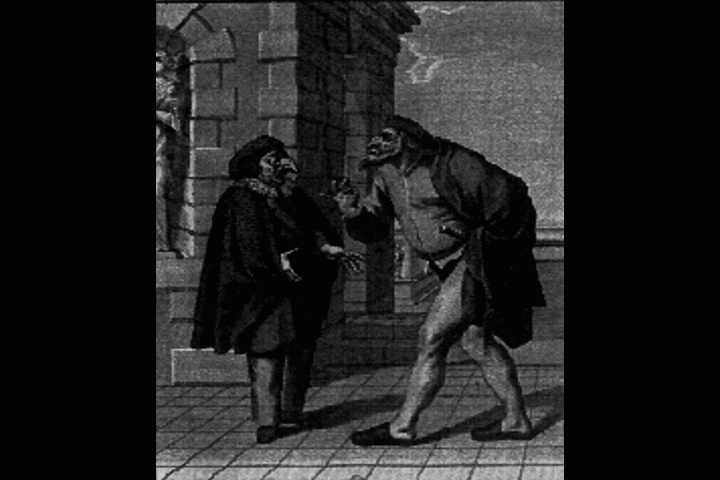 The confidant character is one that supports a main character, either
the protagonist or the antagonist, and offers him a way to speak his mind
in dialogue form. For example, a protagonist in scene with an antagonist
is likely to use rhetorical strategies, or even to outright lie, to achieve
a strategic purpose, but the audience can recognize the character's action
if he has told a confidant, in a previous scene, that he intends to lie.
A confidante is a female version of a character with this function. These
characters can be a best friend, maid or manservant, governess, or tutor.
The ingenue and juvenile are roles that descend from the
Commedia Dell'arte (see picture) of the Middle Ages in Italy. These are characters,
most often found in comedy, who are young, naive, and destined to fall
in love. They often serve as "straight" characters around whom more comical
stock characters operate.
The confidant character is one that supports a main character, either
the protagonist or the antagonist, and offers him a way to speak his mind
in dialogue form. For example, a protagonist in scene with an antagonist
is likely to use rhetorical strategies, or even to outright lie, to achieve
a strategic purpose, but the audience can recognize the character's action
if he has told a confidant, in a previous scene, that he intends to lie.
A confidante is a female version of a character with this function. These
characters can be a best friend, maid or manservant, governess, or tutor.
The ingenue and juvenile are roles that descend from the
Commedia Dell'arte (see picture) of the Middle Ages in Italy. These are characters,
most often found in comedy, who are young, naive, and destined to fall
in love. They often serve as "straight" characters around whom more comical
stock characters operate.
Servant characters became popular in Ancient Roman comedies and have remained popular to the present in modified forms. There are many types of servant characters; one of the oldest is the parasite, who is a clever, greedy, fast-talking schemer. The parasite usually fools a protagonist or antagonist out of money, often performs comic, physical feats of skill, and tends to like earthly pleasures. Another servant character is the fool, perhaps best known now from Shakespeare's fools in such plays as King Lear or As You Like It. The fool is often shown to have a certain wisdom behind his clowning that the audience may comprehend but the other characters on stage will tend not to understand. An analogous female character for the parasite is the soubrette. This term comes from the French in the 17th century, when the playwright Molière wrote many brilliant soubrette parts. She is usually young, outspoken, clever, and flaunts a brazen sexuality. among the many other character types and functions is the grande dame: a middle aged woman's role; usually she drives the plot or characters with money, power, or sexual politics.
There are also typical functions associated with other minor characters; for example an old man or old woman is likely to be either a wisdom figure or a fool, a foil has some characteristics opposite to a protagonist, and a straight man sets up a comic character's jokes, often while pretending not to understand the humor.
Historical Conventions
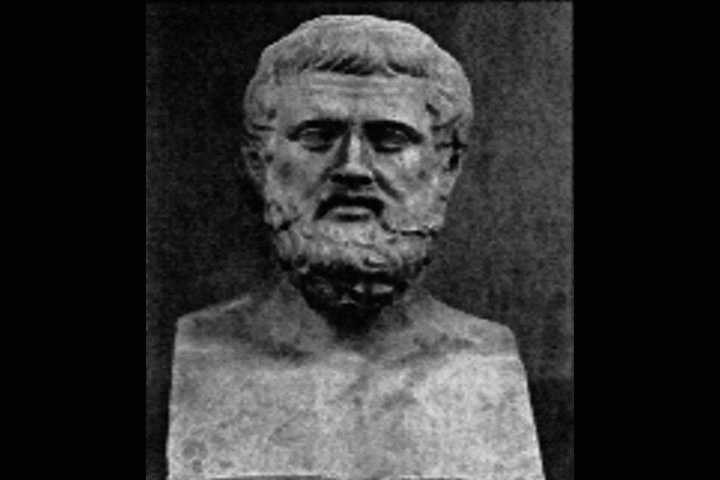 Today the playwright is a respected artist in her own right. She earns a
living by collecting royalties every time a play is produced or
when copies of a play text are sold. However, copyright laws which exist
to protect authors have only been strictly and internationally enforced
for about a century. Before that time, it was harder to earn a living
as a playwright. In Ancient Greek theatre festivals, three playwrights
were chosen each year to compete in the following year's festival. The
chosen writers were then supported by wealthy citizens while they wrote
and rehearsed four plays for the competition. Most writers also had other
specialties outside of theatre; Sophocles (see image), for example, was also
a general in the Athenian army. There was no public theatre that produced
a regular season of plays; theatre was offered only as part of religious
and civic holidays.
Today the playwright is a respected artist in her own right. She earns a
living by collecting royalties every time a play is produced or
when copies of a play text are sold. However, copyright laws which exist
to protect authors have only been strictly and internationally enforced
for about a century. Before that time, it was harder to earn a living
as a playwright. In Ancient Greek theatre festivals, three playwrights
were chosen each year to compete in the following year's festival. The
chosen writers were then supported by wealthy citizens while they wrote
and rehearsed four plays for the competition. Most writers also had other
specialties outside of theatre; Sophocles (see image), for example, was also
a general in the Athenian army. There was no public theatre that produced
a regular season of plays; theatre was offered only as part of religious
and civic holidays.
 In the European Renaissance, playwrights were learned men who earned their
living in other ways, members of the landed gentry who had independent
means, or members of theatre companies who also participated as actors
and/or managers of their companies. Shakespeare (see image) was a shareholding
member of the Lord Chamberlain's Men, later the King's Men, and he acted
in his own plays and took his part in the shared management of the company.
Shakespeare never considered publishing his plays; he received a modest
sum from the company for each new play, after which the play became the
property of the troupe. Molière, the 17th century French playwright,
was also an actor and manager within his company. He became a favorite
of the King of France, Louis XIV, who helped to support Molière's
troupe. Royal or noble patronage became another model by which writers
and actors earned a living. Beginning in the 17th century, playwrights
or companies did publish plays that were successful on the stage.
However, no copyright laws existed to regulate productions of the plays
once they were published. The playwright of a successful play would receive
extra money from a benefit performance, usually the third night
of a play's run; at a benefit the writer received all profit (total income
minus expenses) from the night's performance. In the 18th century, plays
began to have longer runs, or to play more successive nights after the
premiere. At this point playwrights often received the profits from every
third night of the initial run of the play.
In the European Renaissance, playwrights were learned men who earned their
living in other ways, members of the landed gentry who had independent
means, or members of theatre companies who also participated as actors
and/or managers of their companies. Shakespeare (see image) was a shareholding
member of the Lord Chamberlain's Men, later the King's Men, and he acted
in his own plays and took his part in the shared management of the company.
Shakespeare never considered publishing his plays; he received a modest
sum from the company for each new play, after which the play became the
property of the troupe. Molière, the 17th century French playwright,
was also an actor and manager within his company. He became a favorite
of the King of France, Louis XIV, who helped to support Molière's
troupe. Royal or noble patronage became another model by which writers
and actors earned a living. Beginning in the 17th century, playwrights
or companies did publish plays that were successful on the stage.
However, no copyright laws existed to regulate productions of the plays
once they were published. The playwright of a successful play would receive
extra money from a benefit performance, usually the third night
of a play's run; at a benefit the writer received all profit (total income
minus expenses) from the night's performance. In the 18th century, plays
began to have longer runs, or to play more successive nights after the
premiere. At this point playwrights often received the profits from every
third night of the initial run of the play.
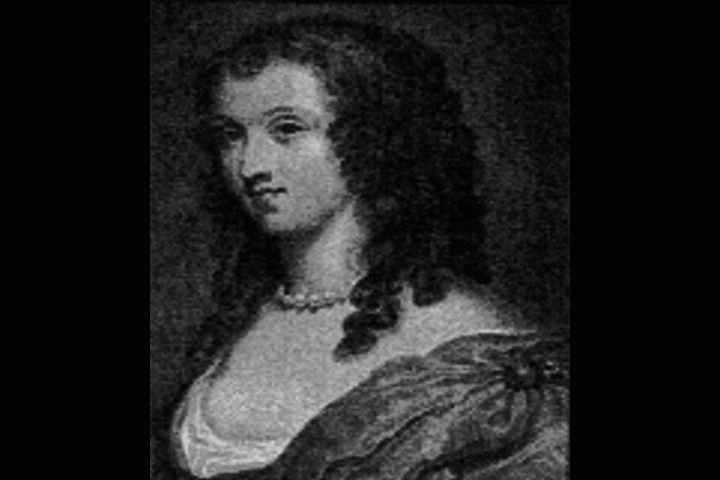 The first women to earn a living as playwrights were English women during
the time of the Restoration, or the late 17th century. Aphra Behn (see
image), for example, became a model for many later women who hoped to
make a living by the pen. Virginia Woolf, writing in the early 20th century,
paid homage to Behn in A Room of One's Own. During the nineteenth
century, when the star system arose which allowed a few "star" actors
to command very high salaries for their performances, a few playwrights
gained similar "star" status and profited enormously from playwriting.
The first of these was the melodrama author Dion Boucicault, who lived
and wrote in England, France, and the United States at various points
in his career. England passed its first copyright law in 1833,
and the United States followed suit in 1856. An international copyright
agreement, protecting a playwright's interest in any production of his
play anywhere in the world, was not achieved until the end of the 19th
century.
The first women to earn a living as playwrights were English women during
the time of the Restoration, or the late 17th century. Aphra Behn (see
image), for example, became a model for many later women who hoped to
make a living by the pen. Virginia Woolf, writing in the early 20th century,
paid homage to Behn in A Room of One's Own. During the nineteenth
century, when the star system arose which allowed a few "star" actors
to command very high salaries for their performances, a few playwrights
gained similar "star" status and profited enormously from playwriting.
The first of these was the melodrama author Dion Boucicault, who lived
and wrote in England, France, and the United States at various points
in his career. England passed its first copyright law in 1833,
and the United States followed suit in 1856. An international copyright
agreement, protecting a playwright's interest in any production of his
play anywhere in the world, was not achieved until the end of the 19th
century.
Professional American playwrights today are members of the Dramatists' Guild, a union that ensures their financial rights and artistic control of their plays in production. They By contrast, the Screenwriters' Guild, the union for American television and screenwriters, does not allow the writer artistic control of a script once it is sold. Playwrights also often publish their plays; writers earn money from the publication and sale of their plays as well as from royalties collected for every production. However, playwrights' works rarely become bestsellers and royalties are only sizable for professional productions. Very few American playwrights today make a living purely by the pen. Most also teach writing or hold other jobs, in or out of the theatre.
Continue Playwright reading...
Back to Blood's home page